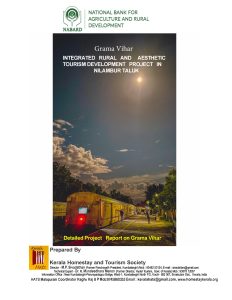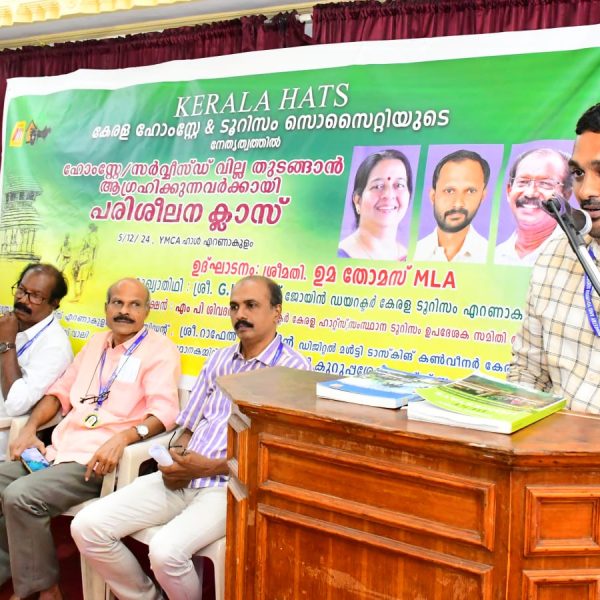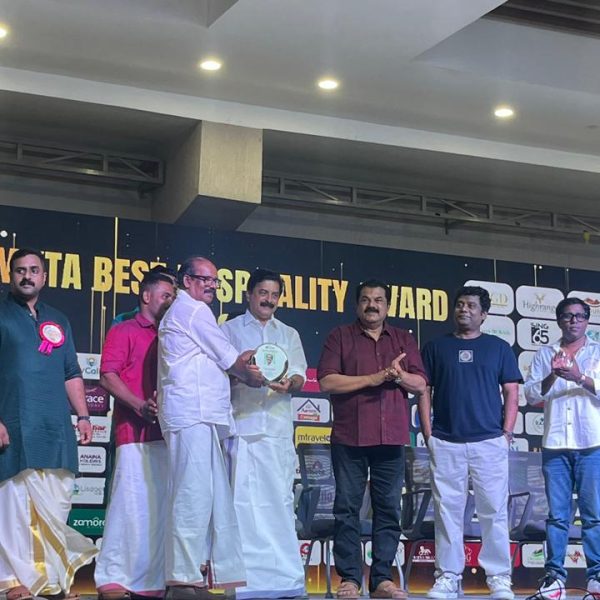 Nilambur Grama Vihar Project (Kerala HATS × NABARD)
Nilambur Grama Vihar Project (Kerala HATS × NABARD)
The Grama Vihar Project in Nilambur is an initiative jointly implemented by the Kerala Homestay and Tourism Society (Kerala HATS) and NABARD to develop rural tourism and strengthen community-based homestays.
The project focuses on converting local homes into quality homestays, improving service standards, and enabling rural families to benefit from tourism.
Key Objectives
- Empower rural families through tourism-based livelihood opportunities.
- Upgrade homestay infrastructure and hospitality standards.
- Provide training in digital marketing, hospitality, hygiene, and guest management.
- Integrate homestays into digital booking platforms to increase visibility and occupancy.
Major Activities
- Capacity-building workshops and hands-on training for homestay owners.
- Infrastructure improvement support — rooms, cleanliness, signage, safety standards.
- Digital enablement — Google Maps listing, social media presence, inclusion in HATS directory and booking platforms.
- Creating local tourism experiences: village walks, plantation visits, culture & cuisine experiences.
Expected Outcomes
- Increase in bookings and income for rural families.
- Standardized, guest-friendly homestays that reflect local culture and hospitality.
- A sustainable rural tourism model that benefits the community and preserves local heritage.
Impact
Nilambur Grama Vihar positions Nilambur as a rural tourism cluster, generating employment, promoting responsible tourism, and uplifting the local economy through homestays.
Grama Vihar Project being implemented in Nilambur (Kerala) in collaboration with Kerala State Homestay & Tourism Society (HATS) and NABARD — putting together what is known and how the project is structured, its objectives, key components, expected outcomes, and how you (with your involvement in Nilambur) can link into it.
Background & Stakeholders
-
The Kerala State Homestay & Tourism Society (HATS) is a state-level agency/association that works to promote homestays, farm-stays and tourism accommodation of a community / local nature in Kerala. Homestay Kerala+1
-
The National Bank for Agriculture and Rural Development (NABARD) is the apex institution in India for credit and development for agriculture and rural sectors—often supporting community-based livelihood, tourism linkages, and rural infrastructure.
-
The Grama Vihar Project appears in mention on the HATS website under “Grama Vihar Project With NABARD” as a partnership. Homestay Kerala
-
Your role: As you noted, you are managing a homestay project in Nilambur (capacity building, digital integration, infrastructure support) in partnership with NABARD, Kerala HATS, RT Mission, etc. So you are already deeply embedded in this context.
Geographic & Local Context – Nilambur
-
Nilambur is in Malappuram district, Kerala. It is known for its lush forest areas (e.g., the teak forest), scenic beauty, back-to-nature tourism potential.
-
A homestay programme here can tap into eco-tourism, rural experience tourism, nature walks, local culture, etc.
-
The local context regarding homestay owners often includes small households, needing training, digital marketing, infrastructure upgrades, and linkages to market (online booking etc). Your project aligns with these needs.
Objectives of the Grama Vihar Project
Based on your description and inferred from HATS/NABARD collaboration, the project likely has these objectives:
-
To support rural households / homestay owners in Nilambur (or similar regions) to upgrade their facilities, services and marketing so as to attract more tourists and thereby increase income.
-
To build capacity: train homestay owners (and your resource person Reghu) in aspects such as hospitality service, hygiene, safety, digital presence & social‐media marketing, guest experience, booking systems, revenue management.
-
To integrate digital marketing and online booking channels (so that homestays aren’t isolated, but connected to state/regional booking portals or the HATS network).
-
To provide infrastructure development support: e.g., improving rooms, common spaces, amenities, signage, sustainable practices (eco-friendly, resource management) — because in rural homestays the guest experience is key.
-
To promote linkages with local culture, community, environment (so that the homestay is not just accommodation but part of a local experience — e.g., forest treks, local food, craft, organic farming tours).
-
To strengthen governance, association, networks of homestay owners (via HATS) so that owners can learn from each other, adopt best practices, access booking networks, maintain standards.
Key Components / Activities
Based on your project elements and likely from HATS/NABARD model, the project would include:
-
Training & capacity building
-
Conduct workshops for homestay owners in: guest service, sanitation & hygiene, hospitality standards, safety, emergencies, legal/regulatory requirements.
-
Digital training: setting up social media pages, taking good photographs of rooms, listing on portals, responding to reviews, pricing strategy.
-
Guest-experience modules: how to create local experiences, manage guest expectations, upselling local products or excursions.
-
-
Infrastructure & quality enhancement
-
Upgrading rooms, furniture, bedding, linen, lighting, ventilation, bathrooms.
-
Creating communal spaces: lounge, verandah, outdoor seating, local craft display.
-
Ensuring eco-friendly practices: waste management, water conservation, local sourcing.
-
Signage and local branding: showing this is a HATS-certified homestay, part of the network, giving confidence to guests.
-
-
Digital integration & marketing
-
Building or improving homestay owners’ presence on the HATS website/directory. HATS has online property registration and booking portal. Homestay Kerala
-
Training on social-media marketing (Instagram/Facebook) to attract domestic and international tourists.
-
Linkage with state tourism department or local tourism boards to promote Nilambur as a destination.
-
Create packages: e.g., stay + forest trek + local food + craft visit.
-
-
Networking & ecosystem linkage
-
Forming clusters of homestay owners in the Nilambur region—so they can exchange best practices, collaborate for shared excursions, transport or guides.
-
Linkage with local services: guides, transport, food supply, local craft vendors, so the homestay ecosystem is enriched.
-
Possibly linking with NABARD financing schemes (for loans, subsidies) for homestay infrastructure or working capital.
-
-
Monitoring & standardisation
-
Implementing a quality checklist for homestays (bed-linen quality, cleanliness, safety, guest feedback) so that “Grama Vihar” branded homestays meet a certain standard.
-
Tracking KPIs: increased number of bookings, higher occupancy rate, guest satisfaction, increased income for homestay owners, employment generation locally.
-
Use of digital dashboards, guest review monitoring, social-media tracking.
-
Expected Outcomes
-
Enhanced income for rural homestay owners in Nilambur through increased occupancy, higher tariffs (justified by quality services), more ancillary services (guided tours, local food, craft).
-
Empowered homestay owners with digital marketing skills, enabling them to operate semi-independently and tap into broader markets (domestic travelers, international eco-tourists).
-
A stronger homestay network in Nilambur, listing under the HATS portal, raising visibility of Nilambur as homestay destination.
-
Improved guest experience, thus higher guest satisfaction, more referrals, repeat business.
-
Community benefits: local employment (guides, transport, cooking), local craft promotion, sustainable tourism practices, conservation awareness (since Nilambur has forest & nature).
-
Long-term sustainability: diversification of rural livelihoods beyond agriculture alone, reducing vulnerability of households, providing alternative income sources through tourism.
Linkage with Your Work & Strategic Suggestions
Given your role in the “Grama Vihar Homestay Project in Nilambur” (capacity building, training, digital integration, infrastructure development, marketing support), here’s how you can align with and amplify the project:
-
Month-wise planning (which you already requested for Reghu) should map to the components above: e.g., Month 1: baseline survey of homestays (facilities, occupancy, digital presence); Month 2-3: training sessions; Month 4-5: infrastructure upgrade phase; Month 6: digital marketing launch; Month 7–12: guest experience enhancement, monitoring, feedback loops.
-
Segment homestay owners: those already operational vs those new; those with strong facilities vs those needing major upgrades. Tailor training/infrastructure support accordingly.
-
Develop a digital toolkit: for homestay owners — sample social-media template, photo-shoot guide, guest-feedback sheet, checklist for guest service, local experiences package template.
-
Local experiences & unique selling propositions (USPs): work with each homestay owner to identify what makes their property unique (forest edge, river view, jungle walk, plantation visit, local craft, Keralan cuisine, bird‐watching). These USPs must feature in their marketing.
-
Collaborate with local stake-holders: forest department (for nature walks), local travel operators, transport services, local restaurants/caterers, craft groups. Ensure guests get a holistic experience.
-
Monitor and measure: set clear indicators (number of bookings, occupancy rate, guest satisfaction score, ancillary income, training completion, digital listing count) and collect data monthly/quarterly.
-
Quality assurance: Ensure that HATS certification or as per project standards is visible. Encourage guest reviews (e.g., Google, TripAdvisor) and respond to feedback.
-
Sustainability & community inclusion: Align services with eco-friendly practices; include local women/families as staff or service providers; promote community heritage (culture, food, craft).
-
Marketing & visibility: Work on listing homestays on national/international platforms; use HATS and state tourism department linkages; run social-media campaigns; perhaps coordinate fam-trips for travel bloggers/influencers to Nilambur region.
Challenges & Mitigation
-
Homestay owners may lack time, finance, or digital skills — provide modular training, peer mentoring, micro-loans (via NABARD) or subsidies.
-
Infrastructure upgrades cost money — link with NABARD financing schemes or state subsidies; ensure cost-effective standards (good enough vs luxury) appropriate to rural setting.
-
Seasonality of tourism — diversify guest source (domestic off-season, weekend travellers, nature lovers) and packaging.
-
Ensuring consistency of guest experience (since many are small operations) — regular training, audit, guest-feedback follow-up.
-
Marketing and visibility — rural homestays can be invisible; so ensure strong online presence, listing, good photography, reviews.
Why This Project Matters
-
It aligns with broader goals of rural livelihoods diversification, sustainable tourism, community empowerment, eco-tourism and local economic development.
-
For Nilambur, with its natural beauty and forest settings, homestays provide an alternative to large hotels/resorts that may be less suitable in such contexts; they leverage local culture, nature and small-scale entrepreneurship.
-
By involving NABARD and HATS, the project taps into institutional linkages (finance, training, marketing networks) which enhance sustainability.
-
The emphasis on digital integration, quality enhancement and networked marketing ensures the homestays are competitive and attractive to modern travellers.




